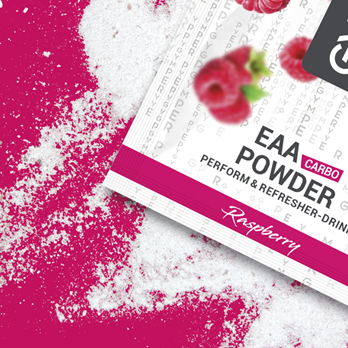
Nutrition and Workout Guide
Nutrition guide: Interesting facts and tips about a healthy and conscious nutrition
A conscious choice of your nutrition not only plays an important role for gaining muscles or during a diet, but affects us all and forms the basis of your physical health. However, the complex topic of a healthy diet can sometimes be difficult.
Our online guide is available for all fitness enthusiasts. In the following sections, we provide all the necessary theoretical basics on healthy nutrition and concepts for individual goals. The acquired knowledge will remain - presented in a clear and concise manner.

Create a nutrition plan in 5 steps
The creation of an individualized nutrition plan is the supreme discipline of any nutrition coach. We would like to show you how you can create your own nutrition plan tailored to your goals and requirements in just 5 simple steps, even without a theoretical background. We have developed a simple and uncomplicated step-by-step guide for this purpose.
1. Calculate your total calorie intake
The exact calculation of your total daily energy expenditure is crucial for the professional creation of a customized nutrition plan.
Basal metabolic rate and resting energy expenditure:
The basal metabolic rate and resting energy expenditure describe the amount of energy we need to maintain vital processes in our body during mental and physical rest. This includes, for example, the functioning of the cardiovascular system and organs or maintaining our body temperature. It depends on various factors such as age, gender, height, weight, body surface area and muscle percentage. In contrast to the resting energy expenditure, however, the basal metabolic rate is measured under precisely standardized conditions: in the morning after approx. 8 hours of sleep in a thermoneutral environment approx. 12 hours after the last meal. The resting energy expenditure is determined under less strict conditions and is approx. 10% higher than the basal metabolic rate, as the body (metabolism, digestion, etc.) is already in a more active state.
Power metabolic rate:
In contrast, the power metabolic rate is determined by our activity level. People who do physically intensive work and also exercise regularly have a higher metabolic rate than someone who has an office job and spends their free time relaxing. An effective nutrition plan can only be created by taking the individual calorie turnover into account. These values form the fixed starting point for all further steps.
Keep in mind: Basal metabolic rate + power metabolic rate = total metabolic rate in kilocalories per day
You can use various methods or formulas for the calculation of the personal total metabolic rate. The Mifflin-St. Jeor formula is a tried and tested formula used by many calorie calculators to calculate the basal metabolic rate:
- For men:
10x weight in kg + 6.25x height in cm - 5x age in years + 5 - For women:
10x weight in kg + 6.25x height in cm + 5x age in years -161
To also take the power metabolic rate into account, we recommend the following multipliers (DGE recommends different multipliers: https://www.dge.de/gesunde-ernaehrung/faq/energiezufuhr/#c2967 )
- Very inactive (office job, little exercise): Basal metabolic rate × 1.2
- Lightly active (light physical activity or sport 1-3 days per week): Basal metabolic rate × 1.4
- Moderately active (sport 3-5 days per week): Basal metabolic rate × 1.5
- Very active (sport 6-7 days per week): Basal metabolic rate × 1.7
- Extremely active (competitive sport, physical work): Basal metabolic rate × 1.9
To gain muscle mass effectively and sustainably, it is essential to increase your protein intake and use high-quality protein sources. If it is difficult for you to meet your increased protein requirements through your normal diet, we recommend our protein products. At Layenberger we have various high-quality products to help you meet your protein requirements, e.g. protein shakes, protein bars, protein muesli and various snacks for in-between meals. We support you in achieving your goals!
High protein diet2. Define your goals and determine your appropriate total calorie intake
Once the total metabolic rate has been determined, the goal is set. When creating the nutrition plan, the total amount of calories planned plays a decisive role, depending on whether the goal is to build muscle or lose weight, for example. A recommendation for this, depending on the specific training goal, is as follows:
- Goal muscle building: calorie surplus (total metabolic rate + 300-500 calories)
- Goal mass gain: calorie surplus (total metabolic rate + 500-800 calories)
- Goal muscle definition: Calorie deficit (total metabolic rate - 300 calories)
- Goal weight loss: Calorie deficit (total metabolic rate - 500 calories)
Layenberger 3K and whey protein shakes help to gain muscles and their definition by providing high-quality proteins and are therefore the ideal supporter in achieving all the above-mentioned goals.
3. Determine the right macronutrient distribution depending on your goal
The percentage distribution of macronutrients (proteins, carbohydrates & fats) in the total energy balance varies depending on the goal. In the context of muscle and mass gain, carbohydrates and proteins play a central role for improving your strength and muscle building. These nutrients are in the focus here.
In order to lose weight, however, fats and proteins are particularly important as a source of energy and to protect the muscles during a calorie deficit. People who are aiming to lose weight through diet without exercise can largely avoid carbohydrates and keep their percentage low.
For those who also do sport and are aiming for muscle definition it is advisable though not to completely eliminate carbohydrates from their diet, as they provide important fuel for your workout. It is advisable to consume the majority of carbohydrates before or after working out.
The recommended macronutrient distribution is as follows:
- Losing weight: 20-30% carbohydrates, 25-30% proteins, 30-35% fat
- Defining muscles: 30-40% carbohydrates, 25-30% proteins, 25-30% fat
- Building muscles / Gaining mass: 55-60% carbohydrates, 20-25% proteins, 15-20% fat
It is important to emphasize that the suggested distribution only serves as a starting point and recommendation. Each person has an individual metabolism that may require adjustments. Factors such as physical condition, age, gender, eating habits, etc. play a decisive role and should also be taken into account.
4. Choose the right products
Once the required amount of calories and the nutrient distribution have been determined, this forms the basic the creation of a nutrition plan. The next step involves selecting the appropriate products to be included in the nutrition plan. Not only must food intolerances be taken into account, but also personal likes and dislikes that are anchored in individual eating habits. In addition, there are also recommendations for the various nutrients:
High-quality protein sources:
- Red lentils, peas, quinoa, kidney beans, soybeans
- Low-fat beef, turkey, chicken, etc.
- Dairy products (curd, yoghurt, cheese)
- Protein shakes for increased protein requirements
If you train hard to build muscle effectively, protein plays a key role. In addition to natural food sources, you can also cover or supplement your increased protein requirements with protein shakes.
High-quality carbohydrate sources:
- Wholemeal products
- Oat flakes
- Potatoes
High-quality fat sources:
- Fish (salmon, mackerel, herring)
- Nuts (almonds, cashew) + seeds (chia, linseed, psyllium...)
- Olive oil, coconut oil (also: nut oils, pumpkin seed oil... Caution, some not suitable for heating)
Choice of nutritional supplements / meal replacement: Regardless of the nutritional goal - either muscle building, mass gain, weight loss or muscle definition - nutritional supplements can make a useful contribution to success. They can compensate for deficiencies (e.g. vitamin and mineral deficiencies, protein deficiencies, etc.) and accelerate certain metabolic processes in the body. Layenberger Fit + Feelgood Slim Shakes and EAA+ amino powders, for example, are suitable for losing weight.
5. Track your progress regularly and adjust your diet plan if necessary
Adjusting your nutrition plans is necessary to respond to stagnation or changes in goals. After a 4-6 week cycle, it is advisable to review the nutrition plan and adjust it if necessary. Possible adjustments can concern the nutrient ratio or the total number of calories. Here are some examples of adjustments:
Failure to lose weight when aiming for weight loss / muscle definition:
- Reduce the total amount of calories by 10% from the initial value
Failure to gain weight when aiming to build muscle / mass:
- Increase the total amount of calories by 10% from the initial value
Increasing your protein intake through functional nutrition is also a popular method for achieving goals. Proteins not only have a satiating effect and therefore support muscle definition or weight loss, but are also essential before and after training when aiming to build muscle. At Layenberger, we have various high-quality products to help you cover your protein requirements, e.g. protein shakes, protein bars, protein muesli and various snacks for in between meals. We support you in achieving your goals!

What is the Body Mass Index (BMI)?
Regardless of whether you want to lose weight, improve your health or actively work on building muscle mass - the Body Mass Index (BMI) is often the first key figure to be determined. Based on your BMI, you can then design your further training and nutrition program. But what exactly is behind this index and how can you calculate your BMI yourself?
What is the BMI?
The Body Mass Index (BMI) is a ratio that measures the relationship between your body weight and your height. It is a useful tool to roughly estimate whether your weight is healthy in relation to your height.
How is the BMI calculated? The BMI calculation is relatively simple: the body weight (in kilograms) is divided by the square of the height (in meters). The formula is as follows:

What does the BMI say?
The resulting BMI value belongs to one of the four ranges that indicates different weight categories. These categories can be broadly categorized as underweight, normal weight, overweight or obese (very overweight).
- BMI below 18.5: Underweight
- BMI 18.5 to 24.9: Normal weight
- BMI 25 to 29.9: Overweight
- BMI 30 or higher: Obesity

There are also differences between women and men and according to age, as the following overviews show:
BMI for women:
The following overview shows you the ideal BMI for women, depending on age.
| Age | Normal weight / ideal BMI |
| 16-17 | 19-24 |
| 18 | 19-24 |
| 19-24 | 19-24 |
| 25-34 | 20-25 |
| 35-44 | 21-26 |
| 45-54 | 22-27 |
| 55-64 | 23-28 |
| 65-90 | 25-30 |
BMI for men:
The following overview shows you the ideal BMI for men, depending on age.
| Age | Normal weight / ideal BMI |
| 16 | 19-24 |
| 17 | 20-25 |
| 18 | 20-25 |
| 19-24 | 21-26 |
| 25-34 | 22-27 |
| 35-54 | 23-28 |
| 55-64 | 24-29 |
| 65-90 | 25-30 |
How do I interpret my BMI?
Based on your BMI value, you can now also calculate your basal metabolic rate and power metabolic rate. The basal metabolic rate indicates how much energy your body uses at complete rest - even if you spend the entire day on the couch. The additional energy required for physical activity is known as the power metabolic rate. Have you already determined these values? Based on these you can then put together your individual training and nutrition program.
For optimum training success, protein shakes, such as the whey protein shake, are an ideal supplement after strength training. They not only promote muscle building, but also support fat burning.
3K protein and whey protein shakesThe BMI is helpful as an initial estimation of your physical condition and supports the creation of training and nutrition plans, but it also has its limitations and does not take into account the distribution of fat and muscle mass, for example. People with a lot of muscle mass can have a higher BMI without being overweight.
For a more accurate estimation, you should consider additional factors such as muscle mass, fat distribution, body surface area and general fitness.

1. Calculate the body fat percentage
In order to reduce body fat, it must first be determined as accurately as possible. The body weight or BMI (see 1.2) only provide limited information about the current body fat percentage.
Women with a body fat percentage of over 30% are considered significantly overweight, whereas the body fat percentage for men is significantly lower. Men should reduce their body fat from a value of 20 % or higher. Various methods are available to determine the current body fat percentage:
- Measuring tape (waist-hip ratio):
- Determines the ratio between waist and hip circumference.
- Provides a rough estimation of the body fat percentage, especially in the abdominal area.
- Easy to perform, but less precise compared to other methods.
- Body fat scale (bioelectrical impedance analysis):
- Measures body fat percentage using electrical impulses sent through the body.
- Requires special scales with integrated electrodes.
- Easy to use, but accuracy can be affected by hydration level and other factors.
- Skin fold measurement (caliper method):
-
- Measures the thickness of skin folds on different parts of the body.
- Calculates the body fat percentage based on these measurements.
- Bioelectrical impedance analysis (BIA):
-
- Sends weak electrical currents through the body.
- Measures the resistance to estimate the body fat percentage.
- Electrical conductivity is different in fatty tissue than in muscles.
- Dual X-ray absorptiometry (DXA):
-
- Uses X-rays to accurately measure the body composition.
- Distinguishes between fat, muscle and bone tissue.
- Hydrostatic weighing test (underwater weighing):
-
- Based on the Archimedean principle.
- Immerse the person under water and measure the displaced volume.
- Calculates the body fat percentage based on density.
- Infra-red interaction measurement:
-
- Uses infra-red light that passes through the tissue.
- Measures the absorption and reflection of light in order to draw conclusions about the fat content.
- Air displacement pIethysmography (Bod Pod):
-
- Measures volume changes when air is removed from a chamber.
- Calculates the body fat percentage based on the density of the body.
- 3D laser scan:
-
- Uses lasers to scan the body surface.
- Creates a 3D model for calculating the body fat percentage.
2. Reduce the calorie intake
An effective method for reducing body fat and calories without compromising metabolism requires a precise approach.
The first step is a targeted reduction in daily calorie intake. This reduction should be based on your personal total energy expenditure.
It is recommended that you aim for a calorie deficit of 500 to 800 kcal per day. You can easily calculate your total energy expenditure using our simple calorie calculator.
3. Apply the correct nutrient distribution
The decisive factor for a successful reduction of body fat is a balanced and calorie-conscious diet. The right choice of food and consistent adherence to a nutrition plan are of great importance.
The nutrition plan is based on high-quality proteins, complex carbohydrates, sufficient fibre and healthy fats. In our step-by-step guide to creating nutrition plans, we have listed the most important points easy to implement:
Generally the intake of carbohydrates is reduced, while the intake of proteins is increased at the same time.
Eiweiß:
Je nach individuellem Bedarf sollten mindestens 0,8 – 1,2 g pro Kilogramm Körpergewicht für die Körperfettreduktion angestrebt werden.
This is why a high protein intake is so important for reducing body fat:
- Prevents muscles reduction
- Prevents a drop of the basal metabolic rate (active metabolism)
- Ensures good satiety and reduces appetite
- Reduces susceptibility to a yo-yo effect
Are you already familiar with our high-quality protein products? Whether it's crunchy muesli, delicious protein bars or creamy protein shakes - here you'll find exactly the right products to suit you and your goals:
Discover our protein productsCarbohydrates:
During body fat reduction carbohydrates act as fuel for your workout sessions. A moderate and sufficient level of carbohydrate intake, around 1 - 2 g per kilogram of body weight, is crucial to stabilize your training level and enable possible performance increases.
Reducing body fat without carbohydrates is not recommended. Going without quickly leads to a drop in performance and mood swings.
Complex carbohydrates such as wholegrain products, oatmeal, rice and potatoes ensure long-lasting satiety and counteract energy loss. To continue to reduce body fat instead of storing it, it is advisable to avoid sugar, white flour products, baked goods and pasta.
Fats:
During body fat reduction the supply of healthy fats plays a decisive role for the hormone balance and the release of testosterone.
When building muscle, aim for around 1 g of fat per kilogram of body weight. To reduce excess body fat, the intake of saturated fatty acids, which are found in many convenience products, industrial baked goods and potato chips, should be avoided.
It is advisable to give preference to vegetable fats that are rich in vitamin E and unsaturated fatty acids. These include olive oil, linseed oil, fish (such as cod and salmon), walnuts and avocado.
4. Reduce and maintain body weight
The goal of reducing body fat is characterized by a loss of body weight. At the beginning, the weight drops faster.
Mit der Zeit werden die Fortschritte kleiner, da der Körper nach Gleichgewicht strebt und der Stoffwechsel sich an die gesenkte Kalorienanzahl gewöhnt. Weniger Hormone werden ausgeschüttet, die Stoffwechselrate sinkt und der Körper verlangt nach mehr Kalorien.
To ensure long-term success and prevent the so-called yo-yo effect, the amount of calories should be slowly adjusted to the actual calorie consumption of the new body weight as soon as the desired value has been reached. It is also advisable to follow a nutrition plan to ensure an optimal distribution of nutrients and to reduce the risk of a calorie surplus.

The protein diet is one of the most popular diets and is particularly known for its simplicity. Because in addition to a calorie deficit, the diet mainly consists of replacing carbohydrates and fats with protein. Nevertheless, there are a few things to bear in mind here too:
To lose weight sustainably and effectively, it is crucial to use high-quality protein sources - this is the only way to achieve your goals. If it is not possible to cover your increased protein requirements through your diet alone, we recommend our tasty protein products as a supplement. From granolas to muesli and protein bars to classic protein shakes - there's something for everyone here. See for yourself:
Proteins are metabolized in a relatively complex way and have the caloric value of carbohydrates (4 kcal or 17 kJ per g), which means that they have a lower energy density compared to fats (9 kcal or 37 kJ per g) or alcohol (7 kcal or 29 kJ). The complex processing of proteins in the body keeps the metabolism active for longer, creating a lasting feeling of satiety and burning more calories. This effect is also known as food-induced thermogenesis. The different levels of energy consumption due to the intake, digestion and utilization of macronutrients are listed below:
- Fat: 0 - 5%
- Carbohydrates: 5 - 10%
- Proteins: 20 - 30%
Weight reduction can therefore be supported by an increased protein intake. This means that if you consume more protein than other nutrients, you consume more energy simply by eating. An additional sports program reinforces this effect, too.
As the body covers its energy requirements by processing its own substance when calorie intake is low, it tends to use muscle cells as an energy source. An increased protein intake counteracts this process. According to experts, the possibility of a yo-yo effect is also lower compared to other diets.
This is how the diet works:
The dominant component of the nutrition during a protein diet consists of protein-rich food.
The diet includes eggs, lean meat, fish, vegetables and dairy products such as low-fat curd, low-fat cheese and yoghurt. Protein shakes can also be integrated into the protein diet. As with any diet, there is a list of products that should be avoided during a protein diet. These include carbohydrate-rich foods such as pasta, rice, potatoes and bread. Due to their high fructose content, fruit should also be eaten in moderate quantities, as should wholemeal products.
Fat, depending on the type, can increase cholesterol levels and should therefore also be consumed in small quantities. Special care should be taken with cold cuts products in particular, as although they are rich in protein, they can often also contain too much unhealthy fat and, in the case of highly processed products, sugar.
Polyunsaturated fats are particularly healthy, including omega-3 fatty acids (a balanced ratio between ω-3 and ω-6 fatty acids is also always important), which are for example found in nuts, linseed and salmon. However, trans fats, such as those found in fried and industrially processed products, should be avoided at all costs.
Advantages of the protein diet:
- Simple implementation
- Easy integration into everyday life
- No hunger
- Low risk of yo-yo effect
- Increased metabolic activation over a longer period of time
- Protection against muscle reduction due to a negative energy balance
Protein shakes - THE supporter during every protein diet:
Protein shakes are the ideal supplement to classic protein-containing nutrition. They make it possible to achieve the optimum effect on a protein diet. Therefore, Layenberger has developed the 3K protein shakes. Not only do they have a high protein content of at least 74%, they also have a high biological value. The combination of the three protein sources soy, whey and milk protein also covers the complete amino acid spectrum and ensures an optimum supply during the diet.

In addition to intensive strength and endurance workouts, an adequate supply of protein is an essential basis for the development of strong muscles and a healthy body. Proteins are not only the components of our muscles, but also fulfill other essential functions in the body by significantly contributing to the growth and maintenance of cells and tissue. The general recommendation is to consume at least 0.8 grams of protein per kilogram of body weight every day. This means, for example, that a person weighing 70 kilograms should consume no less than 56 grams of protein per day. For extreme and competitive athletes, it is recommended to increase the daily protein intake to up to 2.0 grams, as the need for protein increases with increasing training intensity.
Protein powder occupies a prominent position among the many options available for an optimal protein supply. The benefits of these functional nutritional products are extensive and go beyond their traditional use in sports. From supporting muscle building to promoting health in general, our protein powders offer a variety of benefits that make it worth taking a closer look.
Whey, 3K, Slim - which protein powder is right for me?
Whey protein - the classic:
Whey protein, obtained from whey, the liquid by-product of cheese production, is the most popular form of protein powder. Whey protein contains all the essential amino acids and has a high biological value, which means that it is efficiently absorbed and utilized by the body. This rapid absorption makes it an ideal choice for supporting muscle building and post-workout recovery.
Layenberger Whey Protein provides 71g of protein per 100 grams and is also enriched with magnesium and vitamin B6 for optimum use during your workout. A clear recommendation for every athlete!
Discover our Whey protein3K Protein - for a high-quality and long-lasting protein supply:
3K Protein combines the three protein sources soy, whey and milk protein. Each of these sources has a different rate of protein absorption in the body. Whey protein is absorbed quickly and is therefore also quickly available to the body. The combination of the three sources provides an amino acid balance over a longer period of time. Due to the different protein components contained in 3K Protein, a long-lasting release of amino acids is supported. This can be particularly useful to supply the body with protein over a longer period of time, for example between meals, during sleep or during very enduring workout sessions.
The Layenberger 3K Protein Shake is for all those who value a high protein content of at least 74%, an amino acid balance and a long-term protein supply with a high biological value. It is also ideal for protein diets, as the body is supplied with high-quality protein for a long time.
Discover our 3K proteinSlim Shake - the all-rounder for weigh losst:
Our Fit + Feelgood Slim Shakes are designed to have a low calorie content per portion. This helps people who want to lose weight to better control their calorie intake. One of the key ingredients of the Fit + Feelgood Slim Shakes is a high protein content* (*according to Regulation (EU) No. 432/2012). Protein not only helps with satiety, but also supports muscle building and can help maintain muscle mass during weight loss. To keep the shake low in calories, our shakes often contain little sugar and fat. This is particularly important as many people who want to lose weight are careful to reduce their sugar intake.
The Fit + Feelgood Slim Shakes use a high-quality composition of nutrients and are therefore even able to replace a complete meal. The shakes contain fibre, for example, which not only contributes to satiety, but can also aid digestion and stabilize blood sugar levels. One shake has only 215 calories and is therefore the perfect supplement for anyone who is aiming to lose weight or wants to better control their current weight. Our recommendation depending on the objective is:
Lose Weight: replace 2/3 meals
Maintain weight: replace 1/3 of meals
Discover our Fit + Feelgood Slim ShakesThe Layenberger formular diet - Diet5 is the most efficient diet in our product portfolio. LAYENBERGER Diet5 offers you the opportunity to lose weight without the hassle of counting calories and without sacrificing good taste. As a daily ration diet (= 5 portions a day), LAYENBERGER Diet5 is the ideal companion if you want to achieve your desired weight in a smart way.
LAYENBERGER Diet5 is very easy to use: combine 5 portions a day according to your personal taste and get your individual desired daily ration. By consuming 5 units every 2-3 hours throughout the day, you no longer need to worry about hunger or cravings during your diet. We also make sure that your body is supplied with sufficient vitamins, minerals and other essential nutrients thanks to the optimally balanced nutritional profile*. With LAYENBERGER Diet5, monotonous diet days and torture are a thing of the past.
*in accordance with the legal requirements of Regulation (EU) No. 2017/1798
Discover our Diet5 products























